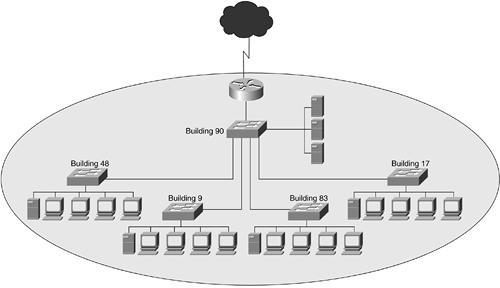Medium and Large Switch-Based Networks
You find yourself in an office-park scenario, or a university campus, where buildings are spread around within a defined perimeter or fence line. Suppose you are managing a network spread across five buildings, for instance, as illustrated in Figure 12-10.
Figure 12-12. Campus LAN

This network is made up of the following:
The switch in Building 90 is the network core providing access to the Internet and a server farm, made up of e-mail, file, and web servers. The Building 90 switch also provides interconnectivity for the switches in the remaining buildings.
Buildings 48, 9, 83, and 17 are offices spread across a corporate office park.
Each building houses sales, engineering, administrative, marketing, and customer service agents.
Each building has a dedicated switch providing connectivity back to the switch in Building 90. For the users in each of these buildings to access resources from another building, their traffic will be switched through the core switch in Building 90. You might use Layer 2 or Layer 3 switching in this scenario, depending on how much of your network is being consumed by broadcasts.
VLANs are another solution that you might implement in a campus scenario.






